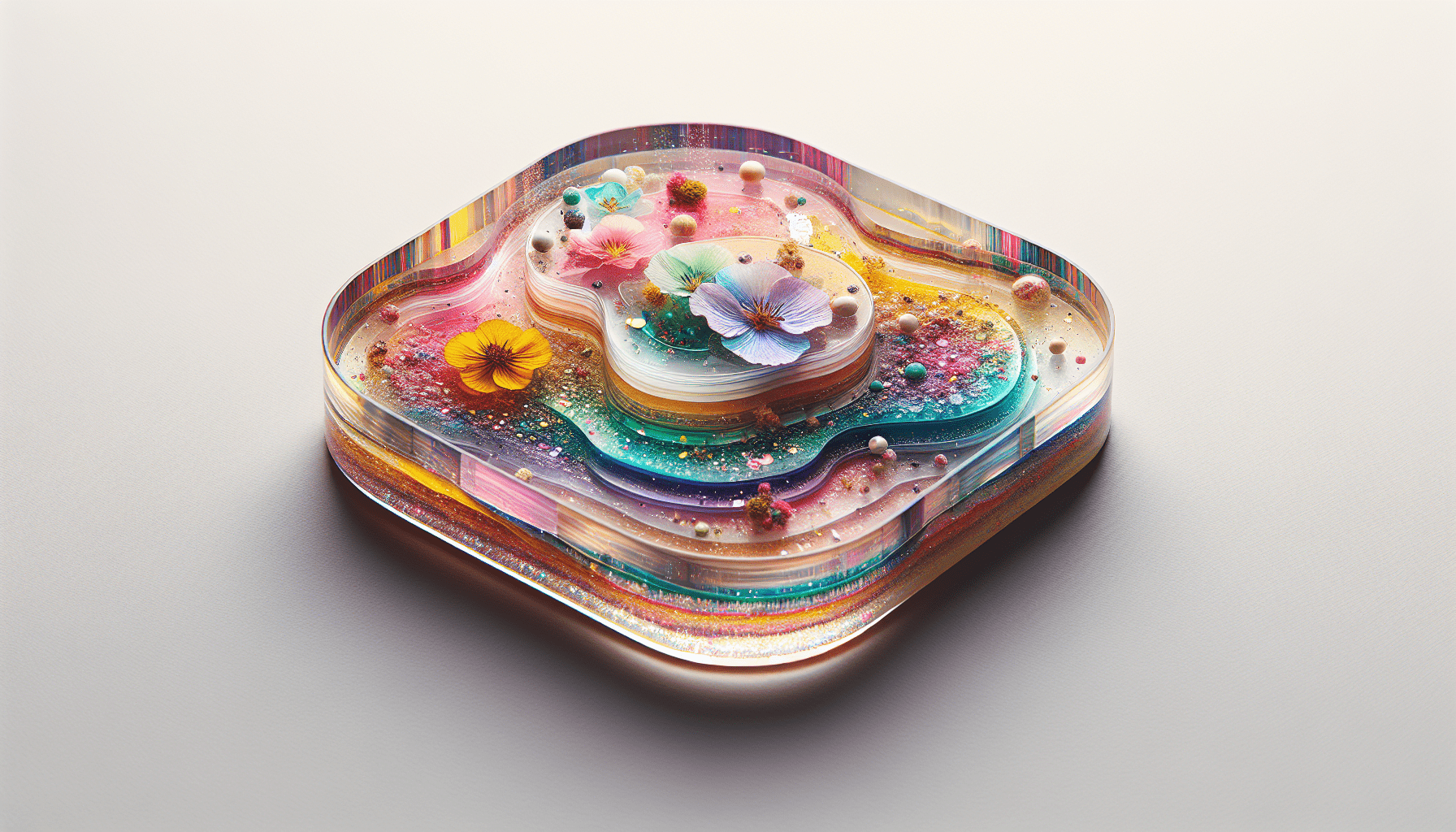What does it mean to create something unique using resin?
Resin art is an exciting and dynamic form of artistic expression that has gained popularity over recent years. It opens up a world of possibilities for artists and hobbyists alike, offering a unique medium that can take many forms. Whether you’re a seasoned crafter or someone completely new to the art scene, there’s something wonderfully captivating about working with resin.
Understanding Resin Art
What is Resin?
To fully appreciate resin art, it’s essential to know what resin actually is. Resin is essentially a viscous substance that hardens when mixed with a curing agent. Typically, two main types of resin are used in art: epoxy resin and polyurethane resin.
- Epoxy Resin: Known for its crystal-clear finish and ease of use, epoxy resin is preferred for many artistic applications, including casting and coating items. Its durability and resistance to yellowing make it a popular choice.
- Polyurethane Resin: This type is often stronger than epoxy resin, offering a higher degree of flexibility and impact resistance. However, it can be a bit trickier to work with due to its sensitivity to temperature and humidity.
Understanding these two types will guide you in selecting the right resin for your projects.
What Makes Resin Art Unique?
There are several factors that contribute to the uniqueness of resin art. Here are a few:
- Vibrant Colors: Resin can hold vibrancy like no other medium. Artists can enhance their creations using resin dyes or pigments, often achieving stunning visual effects.
- 3D Depth: The capacity to create layers with resin allows for fascinating depth in your artwork. This can give the illusion of a three-dimensional piece, inviting viewers to look closer.
- Customization: You can incorporate all sorts of materials into your resin art—dried flowers, glitter, or even photographs. This level of personalization is what truly makes each piece one-of-a-kind.
- Versatility: Resin can be used on various surfaces, including wood, canvas, and even metal. This adaptability helps artists express their creativity freely.
Finding your unique voice in resin art can be a rewarding experience.
Getting Started with Resin Art
Materials You’ll Need
Starting any artistic endeavor requires gathering the right tools. Here’s a basic list of materials you’ll need to create your resin art pieces:
| Material | Purpose |
|---|---|
| Epoxy or Polyurethane Resin | The main medium for your artwork |
| Hardener | Used to cure the resin |
| Mixing Cups | For combining the resin and hardener |
| Stirring Sticks | Essential for thorough mixing |
| Gloves | Protect your hands during the process |
| Protective Gear | Safety glasses and a mask, especially for ventilation |
| Color Pigments/Dyes | To add color to your resin |
| Molds or Canvas | Depending on the project you want to create |
| Heat Gun or Torch | Help remove bubbles from the resin during curing |
| Sanding Tools | For smoothing the edges after curing |
Make sure you also have a clean, well-ventilated workspace to ensure safety and ease of cleaning.
Preparing Your Workspace
Creating a designated workspace is key for successful resin art projects. Here are some tips to set up a perfect area:
- Clean Surface: Choose a flat, non-porous surface that’s easily wipeable, such as a plastic table.
- Ventilation: Ensure your workspace is well-ventilated. Resin involves chemicals that can release fumes, so proper airflow is important.
- Protective Covers: Use plastic sheets or newspapers to cover surfaces, as resin can be a tad messy.
- Organized Tools: Keep your materials organized. Having everything at hand will help you work more efficiently without interruptions.
Taking the time to prepare your workspace will make the entire process smoother!
Techniques in Resin Art
Pouring Techniques
The pouring technique is one of the most popular methods used in resin art. It involves pouring mixed resin onto your surface and letting it settle. Here are some methods you can explore:
- Dirty Pour: This involves pouring multiple colors simultaneously into one cup before transferring it onto your canvas. The result is a beautiful blend of colors that create unique patterns.
- Layered Pour: In this technique, you pour different colors in layers, allowing each layer to set for a while. This creates an illusion of depth and dimension.
Understanding these techniques helps you achieve various effects, adding flair to your art pieces.
Mold Techniques
Molds can take your art to unique dimensions. Here’s a couple of methods you can try:
- Silicone Molds: These are flexible and allow for easy removal once the resin has cured. You can create coasters, trays, or decorative shapes.
- Custom Molds: If you want to unleash your creativity, consider making custom molds using materials like clay or 3D printing. This allows for endless possibilities tailored to your vision.
Using molds can take your resin art to the next level, allowing for different shapes and designs that aren’t possible with free pouring.
Embedding Objects
One of the most fascinating aspects of resin art is the ability to embed objects within the resin. Consider embedding items like:
- Dried flowers: These can add a natural touch.
- Glitter: Perfect for those wanting a sparkling finish.
- Trinkets: Small personal items can turn a piece into a memorable keepsake.
Embedding objects can create a story within your art, making each piece even more special.
Safety Precautions
Handling Resin Properly
Working with resin does require some safety precautions. Here are a few important points to keep in mind:
- Use Protective Gear: Always wear gloves and safety glasses to protect your skin and eyes from potential splashes.
- Safety in Ventilation: Work in a well-ventilated area to avoid inhaling fumes. A mask can also be beneficial if you’re particularly sensitive.
- Emergency Preparedness: Keep a first aid kit nearby. Though accidents are rare when done carefully, it’s better to be prepared.
Being proactive about safety ensures you can enjoy the process without unnecessary risks.
Proper Disposal
Once you’ve finished your project, don’t forget about disposing of leftover resin and materials properly. Here are guidelines:
- Cured Resin: Once fully cured, resin is safe to dispose of in your regular trash.
- Uncured Resin: This requires careful disposal. Check local regulations for hazardous waste disposal, as some areas have specific guidelines.
These small steps are crucial in ensuring environmental safety.
Caring for Your Resin Art
Curing Process
Curing is an essential step in resin art. Here’s what to keep in mind:
- Timeframe: Depending on the type of resin you use, curing can take anywhere from a few hours to a couple of days. Be patient and avoid touching the surface until it’s fully set.
- Conditions: Ensure the area is free from dust and debris. This helps maintain the crystal-clear finish you’re aiming for.
Allowing the proper time for curing is key to achieving the best results.
Cleaning and Maintenance
Once your resin art is created, you want to keep it looking fresh. Here are a couple of cleaning tips:
- Regular Dusting: Use a microfiber cloth to gently dust your pieces. This protects the surface and keeps them shiny.
- Avoid Harsh Chemicals: When cleaning, avoid harsh cleaners or abrasives as they might scratch or dull the surface of your artwork.
Keeping your resin art in pristine condition is a way of showing appreciation for your hard work.
Inspiration for Your Projects
Finding Ideas
Getting inspired can often be the hardest part of any creative endeavor. Here are ways to find motivation for your resin art projects:
- Nature: Look around you! Nature offers beautiful color schemes and patterns that can be reimagined.
- Social Media: Platforms like Instagram and Pinterest are filled with creatives sharing their work. Following resin artists and project ideas can spark your creativity.
- Art Shows & Galleries: Visiting local galleries or shows can expose you to different styles and mediums, providing new perspectives.
Finding inspiration can help you unleash your creativity, leading to unique project ideas.
Project Ideas to Try
If you’re looking for something specific to create, here are some project suggestions:
- Coasters: Easy to start with, coasters provide a functional and decorative way to use resin.
- Jewelry: Create beautiful pendants or earrings using small molds or even embedding tiny objects.
- Artwork: Pour resin onto a canvas to create vibrant, abstract pieces that can liven up any space.
These ideas can help you get started as you cultivate your resin art skills.
Conclusion
Resin art invites you to express your creativity in vibrant and dynamic ways. It’s an engaging journey that combines artistic flair with experimental techniques. With the right materials, safety knowledge, and a sprinkle of inspiration, you can create breathtaking pieces that reflect your unique style.
As you embark on your resin art journey, remember that practice makes perfect. Don’t be afraid to experiment with colors, techniques, and embedding methods. Each project is a learning opportunity, helping you refine your skills and ignite your creative potential.
Now, are you ready to create your very own resin masterpiece? Grab your materials, set up your workspace, and let your imagination run wild!


Leave a Reply